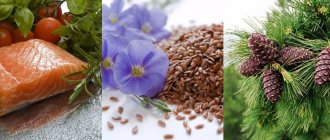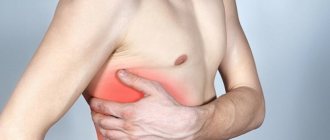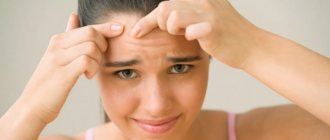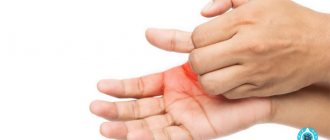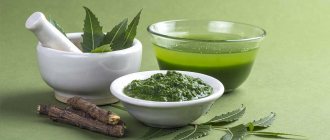Skin lesions on the hands, face and body in adults
Dermatitis is manifested by rashes on the skin of the face, hands and other parts of the body, as well as itching and burning in the affected areas. The main cause of the disease is skin contact with substances that are irritants. Food allergens can also aggravate dermatitis.
In this case, a characteristic feature is rashes that are not localized at the points of contact of the epidermis with external irritants. For dermatitis, a specialist prescribes a number of remedies. The main measure is antihistamines. A special diet is also shown, which is based on foods with low allergenicity that are not capable of acting as irritants.
Exacerbation period
At this time, strict adherence to the diet is important; nutrition should be based on the principles of desensitization and hypoallergenicity. Any, even potentially dangerous, food is eliminated. As symptoms decrease, the list of dishes can be expanded slightly, taking into account the type of dermatosis and individual contraindications.
Cooking method: stewing, baking in the oven, boiling, steaming. Excess salt, spices, herbs are not allowed.
It is better to eat homemade food, since canteens and restaurants often use products containing preservatives and harmful ingredients.
The diet menu should not be compiled independently, but together with a nutritionist-allergist. Based on the examination, the specialist will select the optimal diet, taking into account the type of disease and the individual characteristics of the patient.
Steamed food is optimal for exacerbations
Nutrition
Regardless of the type of disease, the diet should be based on the following principles:
- Highly allergenic foods are excluded from the menu.
- Food should be homemade and natural.
- Dishes can be boiled, baked, steamed. Frying should be avoided.
- The use of salt and spices is minimized.
- You need to eat small meals at least four times a day. The last meal should be at least 3-4 hours before bedtime.
- You need to drink enough water
- White bread should be replaced with whole grain bread.
- It is useful to add bran to food.
- Vegetables and hypoallergenic fruits containing fiber are recommended, including green apples.
Interesting article: Hypoallergenic diet for atopic dermatitis
In the atopic form, a classic diet is indicated with the gradual elimination from the diet of foods that can provoke allergies. You can consume some fruits and fresh juices from them. Red and orange fruits and vegetables are excluded. It is recommended to eat apples, pears, plums - they help cleanse the body and treat the disease. Useful cereals include rice, oatmeal, and pearl barley.
Allergic dermatitis involves strict prohibitions. All prohibited allergenic foods must be eliminated. If a food is found that provokes unpleasant symptoms, it must be excluded. Fatty, spicy, salty foods are prohibited. Fermented milk products, seasonal vegetables and fruits are useful. With seborrheic dermatitis, allergens are also limited. New products are introduced gradually, every 2-3 days, with response monitoring.
Dühring's dermatitis is a persistent chronic disease caused by incomplete absorption of gluten. Any food containing wheat, flour, malt components, sweets, or semi-finished products is prohibited. You also need to exclude legumes, grains, cabbage, pasta, and sausages.
For contact dermatitis, the diet is similar to the menu for allergic forms.
To remove allergens, you need to drink a lot of water.
Useful
The dietary intake for the treatment of allergic dermatitis must include:
- cabbage;
- white meat;
- apples of different varieties;
- cottage cheese and fermented milk products;
- pumpkin;
- pears;
- oatmeal, rice and semolina.
In case of seborrheic form of pathology, it is also allowed to eat:
- berries and fruits;
- lots of vegetables;
- products with natural collagen (jelly, jellied meat).
Dühring's dermatitis involves following a menu with the presence in it of:
- baking using soy, rice or corn flour;
- porridge (buckwheat, rice and corn);
- boiled meat or fish;
- homemade mayonnaise;
- milk;
- potatoes;
- beets, zucchini;
- fruit;
- natural coffee;
- salts without the presence of iodine.
If you correctly choose the optimal diet, follow all the recommendations of a specialist and at the same time use medication treatment, then you can cure dermatitis quite quickly.
What can you eat?
The menu for dermatitis is based on hypoallergenic products that promote faster renewal of skin cells and restoration of the body.
These include the following:
- porridge with water (oatmeal, rice, millet, buckwheat, pearl barley);
- vegetables (cabbage, turnips, zucchini, cucumbers, squash);
- boiled lean meat (chicken, turkey, rabbit, beef);
- non-allergenic fruits rich in fiber and vitamins (unsweetened green apples, plums, white currants, watermelon);
- fermented milk drinks (kefir, cottage cheese, natural sourdough yogurt);
- some types of fish containing high amounts of omega-3;
- seaweed;
- vegetable oil (up to 30 grams per day);
- green tea, herbal infusions, homemade compotes and fruit drinks.
It is also important to drink enough water - it helps remove toxins from the body and speed up recovery processes.
Interesting article: Nutrition and diet for allergic dermatitis: what can adults eat?
Authorized Products
The first courses are prepared in a weak vegetable broth without frying with the addition of garden herbs. The diet includes lean boiled (without skin) or stewed dietary meat of turkey, chicken or rabbit. As a side dish, it is allowed to use potatoes pre-soaked in water, boiled in water in the form of mashed potatoes or in separate pieces.
Among the cereals, the diet may include buckwheat, wheat and oatmeal. From the group and dairy products - low-fat fermented milk products, yogurt without additives, fresh low-fat cottage cheese. It is allowed to include bran/whole grain bread, dry biscuits, and durum wheat pasta in the diet.
Fats must include vegetable oils (sunflower or olive). Vegetables: cucumber, onion, lettuce, stewed/boiled zucchini, boiled or stewed cabbage.
Table of permitted products
| Proteins, g | Fats, g | Carbohydrates, g | Calories, kcal | |
Vegetables and greens | ||||
| eggplant | 1,2 | 0,1 | 4,5 | 24 |
| zucchini | 0,6 | 0,3 | 4,6 | 24 |
| cabbage | 1,8 | 0,1 | 4,7 | 27 |
| broccoli | 3,0 | 0,4 | 5,2 | 28 |
| Brussels sprouts | 4,8 | 0,0 | 8,0 | 43 |
| cauliflower | 2,5 | 0,3 | 5,4 | 30 |
| green onion | 1,3 | 0,0 | 4,6 | 19 |
| bulb onions | 1,4 | 0,0 | 10,4 | 41 |
| cucumbers | 0,8 | 0,1 | 2,8 | 15 |
| squash | 0,6 | 0,1 | 4,3 | 19 |
| parsley | 3,7 | 0,4 | 7,6 | 47 |
| salad | 1,2 | 0,3 | 1,3 | 12 |
| celery | 0,9 | 0,1 | 2,1 | 12 |
| soybeans | 34,9 | 17,3 | 17,3 | 381 |
| asparagus | 1,9 | 0,1 | 3,1 | 20 |
| Jerusalem artichoke | 2,1 | 0,1 | 12,8 | 61 |
| dill | 2,5 | 0,5 | 6,3 | 38 |
| beans | 7,8 | 0,5 | 21,5 | 123 |
| garlic | 6,5 | 0,5 | 29,9 | 143 |
| lentils | 24,0 | 1,5 | 42,7 | 284 |
Fruits | ||||
| pears | 0,4 | 0,3 | 10,9 | 42 |
| nectarine | 0,9 | 0,2 | 11,8 | 48 |
| peaches | 0,9 | 0,1 | 11,3 | 46 |
| apples | 0,4 | 0,4 | 9,8 | 47 |
Berries | ||||
| gooseberry | 0,7 | 0,2 | 12,0 | 43 |
| black currant | 1,0 | 0,4 | 7,3 | 44 |
Nuts and dried fruits | ||||
| flax seeds | 18,3 | 42,2 | 28,9 | 534 |
| sunflower seeds | 20,7 | 52,9 | 3,4 | 578 |
Cereals and porridges | ||||
| buckwheat (kernel) | 12,6 | 3,3 | 62,1 | 313 |
| semolina | 10,3 | 1,0 | 73,3 | 328 |
| oat groats | 12,3 | 6,1 | 59,5 | 342 |
| cereals | 11,9 | 7,2 | 69,3 | 366 |
| wheat bran | 15,1 | 3,8 | 53,6 | 296 |
Raw materials and seasonings | ||||
| basil | 2,5 | 0,6 | 4,3 | 27 |
Dairy | ||||
| dairy products | 3,2 | 6,5 | 4,1 | 117 |
| kefir 0% | 3,0 | 0,1 | 3,8 | 30 |
| kefir 1% | 2,8 | 1,0 | 4,0 | 40 |
Cheeses and cottage cheese | ||||
| cottage cheese 0.6% (low fat) | 18,0 | 0,6 | 1,8 | 88 |
| curd tofu | 8,1 | 4,2 | 0,6 | 73 |
Meat products | ||||
| boiled beef | 25,8 | 16,8 | 0,0 | 254 |
| beef stew | 16,8 | 18,3 | 0,0 | 232 |
Bird | ||||
| boiled chicken | 25,2 | 7,4 | 0,0 | 170 |
| steamed chicken breast | 23,6 | 1,9 | 0,0 | 113 |
| boiled turkey fillet | 25,0 | 1,0 | — | 130 |
Fish and seafood | ||||
| seaweed | 0,8 | 5,1 | 0,0 | 49 |
Oils and fats | ||||
| butter | 0,5 | 82,5 | 0,8 | 748 |
| linseed oil | 0,0 | 99,8 | 0,0 | 898 |
| olive oil | 0,0 | 99,8 | 0,0 | 898 |
| sunflower oil | 0,0 | 99,9 | 0,0 | 899 |
Non-alcoholic drinks | ||||
| mineral water | 0,0 | 0,0 | 0,0 | — |
| instant chicory | 0,1 | 0,0 | 2,8 | 11 |
| green tea | 0,0 | 0,0 | 0,0 | — |
Juices and compotes | ||||
| rose hip juice | 0,1 | 0,0 | 17,6 | 70 |
| * data is per 100 g of product | ||||
What should you not eat?
All foods considered allergens are usually excluded from the diet. These include the following:
- Honey. It cannot be consumed in its pure form or added to various dishes and drinks.
- Eggs. Although this is a healthy product in principle, it can easily cause allergies. It is especially important to limit their use for dermatitis in children.
- Cocoa. This drink increases the load on the liver and can cause an exacerbation of dermatitis.
- Whole milk. It is also an allergen and can cause a relapse.
- Nuts. All types are excluded.
- Citrus. Despite their benefits, these are highly allergenic products. Exotic fruits of red and orange colors are also prohibited.
Also, an exacerbation of the disease can be provoked by the consumption of smoked, fatty, fried, pickled foods. Seafood, caviar, and fatty meat are excluded. Spices, salt and sugar are limited. Do not drink alcohol, sweet juices, or carbonated drinks.
Each person’s body is individual, and you need to monitor the reaction to specific products. If a certain dish provokes signs of the disease, it must be excluded.
Interesting article: Therapeutic diet for facial demodicosis with a table of permitted and prohibited foods
Body need
It is impossible to achieve a positive result by excluding only irritating foods from the menu. At the same time, a person should receive components that will help balance the functioning of the immune system and ensure the ability to restore the integrity of the epithelium. What substances are needed:
- During the diet, products containing lactobacilli are used. The presence of obligate microflora ensures the normal functioning of the digestive tract. Dysbacteriosis is a frequent companion to allergies; these processes are interconnected, so restoration of intestinal microflora is a valuable element in the treatment of the disease. A person’s diet should contain fresh fermented milk products with a short shelf life every day: bifidok, yoghurts, kefir, yogurt. If lactose is intolerable, probiotics are taken - medications containing bacteria necessary for the balanced functioning of the digestive system.
- For dermatitis of any etiology, sufficient consumption of unsaturated fatty acids is important. It is a building material for cells that protects their membranes from destruction. They remove toxins and participate in eliminating inflammatory processes. With their regular use, the skin restores elasticity, itching and flaking are reduced. Products containing the necessary component are vegetable oils, sea fish and algae. You can buy capsules with Omega-3 acids at the pharmacy.
- B vitamins help in the fight against irritation and stress during an exacerbation, restore the functioning of the central nervous system, and normalize sleep. B9 plays a special role, otherwise known as folic acid, it activates metabolic reactions, resists dry skin, and accelerates regeneration. The diet includes lean meat, liver, and greens.
- Zinc is needed for the health of the epithelium; the element is involved in the normal functioning of skin cells. Participates in their division, stabilizes the condition of membranes, removes toxins. With its deficiency, the skin becomes dry, resulting in increased irritation and itching. The substance is present in pumpkin, cereals, and yeast.
- Antioxidant protection of the epithelium is an important component of the treatment of dermatitis. These include selenium, its highest content is in turkey meat, bran bread, oatmeal, and animal kidneys. The microelement is consumed with vitamin E; there is enough of it in vegetable oils and seeds.
When forming a diet, it is necessary to include these substances in the diet for any form of skin pathology.
Dairy products restore the functioning of the gastrointestinal tract
Menu for the week
The diet will depend on the characteristics of the patient’s body and the type of dermatitis.
The main thing is to exclude harmful foods from your diet and build it taking into account all the rules.
Below is a sample weekly menu for patients with dermatitis.
Monday
- Breakfast: buckwheat, whole grain bread with butter, tea.
- Lunch: vegetable soup with sour cream, boiled meat, rice.
- Afternoon snack: baked apple.
- Dinner: steamed fish cutlets, cucumber and herb salad, tea.
Tuesday
- Breakfast: oatmeal with dried fruits, low-fat cheese, tea.
- Lunch: soup with noodles, buckwheat with meat, fruit juice.
- Afternoon snack: kefir.
- Dinner: stewed potatoes with liver, cabbage salad, jelly.
Wednesday
- Breakfast: rice, cottage cheese, tea.
- Lunch: soup with meatballs, steamed lean meat, stewed cabbage.
- Afternoon snack: natural yogurt.
- Dinner: boiled potatoes with a little butter, steamed cutlets, tea.
Thursday
- Breakfast: oatmeal, buttered bread, herbal tea.
- Lunch: vegetable soup, pilaf, homemade compote.
- Afternoon snack: pear.
- Dinner: rabbit stew with vegetables, sour milk.
Friday
- Breakfast: mashed potatoes, vegetable salad, cheese, tea.
- Lunch: puree soup with zucchini, steamed cutlets, rice, berry juice.
- Afternoon snack: yogurt.
- Dinner: steamed meatballs, boiled potatoes.
Interesting article: Features of the diet for Zhiber rosea
Saturday
- Breakfast: toast with low-fat cheese and herbs, tea.
- Lunch: buckwheat soup with meat broth, stewed cabbage, beef liver, jelly.
- Afternoon snack: jelly.
- Dinner: potatoes baked with zucchini, a glass of kefir.
Sunday
- Breakfast: zucchini caviar, whole grain bread, homemade juice.
- Lunch: vegetable soup, meat balls, buckwheat, compote.
- Afternoon snack: cottage cheese with added dried fruits.
- Dinner: boiled fish, vegetable salad, tea.
Interesting article: Nutrition and diet for seborrheic dermatitis in adults: what can and cannot be eaten?
Diet for Dühring's dermatitis
Dühring's dermatitis occurs severely in the patient, with complications. The main cause of the skin reaction is impaired absorption of gluten in the stomach. Gluten is a plant protein obtained from grains, so to recover, an allergy sufferer needs to exclude products based on wheat, barley, and oats. When buying food in a store, read the ingredients.
Be sure to exclude from your diet:
- Dishes made from wheat flour and malt;
- Beer, kvass;
- Chicory and other coffee substitutes;
- Ice cream, creams;
- Sweets (chocolate, pastries, cakes) with filling;
- Cereals: oats, barley, wheat, millet, pearl barley;
- Legumes (peas, chickpeas, beans);
- Pasta, dumplings, dumplings, baked goods, pancakes, crackers;
- Breaded meat products;
- Sausages.
Classification
In the international classification ICD-10 code L10-L14 Bullous Disorders .
According to sources, the categories of bullous dermatitis that cause skin lesions are as follows:
- Solar bullous dermatitis (due to exposure to ultraviolet rays);
- Metabolic bullous dermatitis (formed due to disruptions in the body's metabolic processes);
- Chemical bullous dermatitis (forms after contact with toxins);
- Temperature bullous dermatitis (formed as a result of frostbite or burns of dermal tissue);
- Allergic contact dermatitis (action of aggressive substances such as salts, alkalis, acids);
- Mechanical dermatitis (which is usually referred to as “wet callus”, is formed under the influence of friction);
- Allergic;
- Congenital;
- Diabetic;
- Mixed dermatitis.
| Substances that cause dermatitis | ||||
| Plants | Metals and their salts | Substances that contain rubber | Chemicals and Medicines | |
| Poison Ivy Poison Oak Poison Hogweed Chrysanthemum Artichoke Daisy Hyacinth Daffodil Carrot Celery Citrus Lichen Primrose | Nickel sulfate Potassium dichromate Mercury bichloride Cobalt sulfate and chloride Gold chloride Copper sulfate Silver nitrate Aluminum chloride Sodium arsenic | Mercaptobenzothiazole Dibenzothiazole disulfide Thiuram Paraphenylenediamine | Tar Ethylenediamine Formalin Neomycin sulfate Turpentine Wax Lanolin Acrylic Benzyl alcohol Benzocaine Procaine Lidocaine Diaminodiphenylmsane Dichlorophene Nitrofurazone Hexachlorophene Ethylparaben Tripelenamide Iodochlorohydroxynoline Charcoal Rosin | |
Hypoallergenic diet. Which fruits are suitable for an adult or child with allergies?
But it turns out that not all fruits cause severe allergies. Some of them can be eaten, but be careful, you must consult your doctor, because all fruits, without exception, can cause allergies.
Let's figure out what fruits you can eat if allergens are not identified.
The color YELLOW should be limited in consumption. It is not safe to eat foods with this color, but it is allowed. Of course, only after consulting a doctor.
Fruit fruits fall almost directly into the colors of these categories.
Important! Bananas are on the yellow list, but people with latex allergies should absolutely not eat bananas.
Note: Pregnant women without allergy symptoms should also not eat the listed prohibited foods from the red list. In addition, you should follow a hypoallergenic diet in the first months of breastfeeding so as not to cause allergic reactions in your child in the form of diathesis.
Dear readers, remember that by following these recommendations and eating approved foods, you can live healthy and fulfillingly, despite your allergies.
Source: https://pitanielife.ru/allergiya/frukty.html

